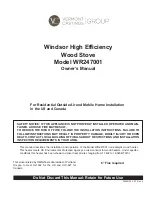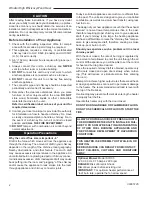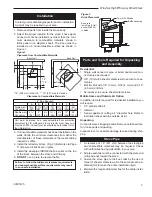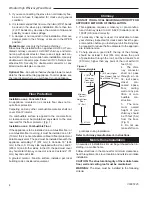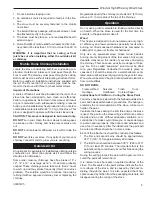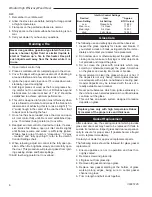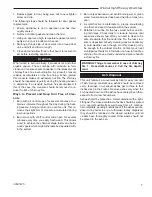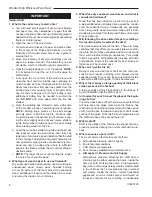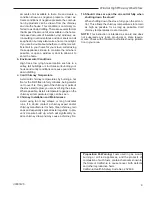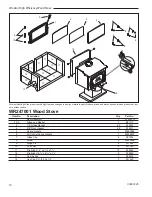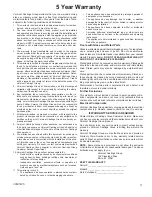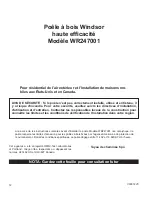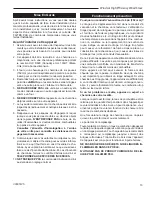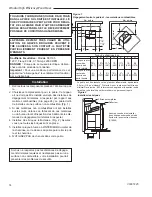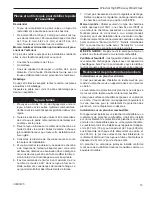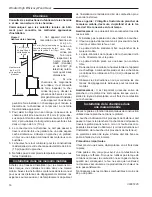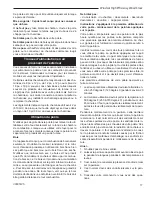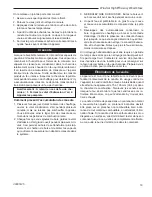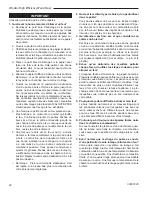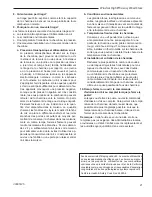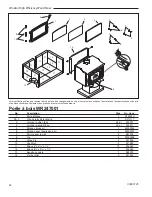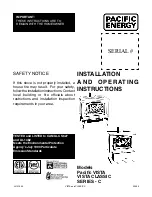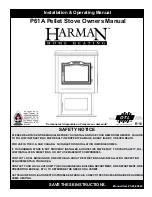
8
Windsor High Efficiency Wood Stove
30005125
iMpORtaNt
Helpful Hints
1. What is the correct way to start a fire?
a. You will need small pieces of dry wood (kindling)
and paper. Use only newspaper or paper that has
not been coated or had unknown materials glued or
applied to it. Never use coated (typically advertising
flyers) or colored paper.
b. Open the door of the wood stove.
c. Crumple several pieces of paper and place them
in the center of the firebox and directly on to the
firebricks of the wood stove. Never use a grate to
elevate the fire.
d. Place small pieces of dry wood kindling) over the
paper in a teepee manner. This allows for good air
circulation, which is critical for good combustion.
e. Light the crumpled paper in 2 or 3 locations:
NOtE:
It is important to heat the air in the stovepipe for
draft to start.
f. Fully open the air control of the wood stove and
close the door until it is slightly open, allowing for
much needed air to be introduced into the fire box.
Never leave the door fully open as sparks from the
kindling may occur causing injury or property dam-
age. As the fire begins to burn the kindling, some
additional kindling may be needed to sustain the
fire.
dO NOt
add more paper after the fire has
started.
g. Once the kindling has started to burn, add some
of the smaller pieces of seasoned (dry) firewood.
NOtE:
Adding large pieces at the early stages
will only serve to smother the fire. Continue add-
ing small pieces of seasoned (dry) firewood, keep-
ing the door slightly open until each piece starts to
ignite. Remember to always open the door slowly
when placing wood into the fire.
h. Once the wood has started to ignite and the smoke
has reduced, close the wood stove door fully. The
reduction of smoke is a good indication that the draft
in the chimney has started and good combustion is
now possible. Larger pieces of seasoned (dry) fire-
wood can now be added when there is sufficient
space in the firebox. Adjust the air control setting to
desired setting.
i.
NOtE:
The lower the air control setting the longer
the burn time of your firewood.
2. What type of wood is best to use as firewood?
Dry seasoned hardwood should be used. Avoid green
unseasoned wood. Green wood, besides burning
at only 60 percent of the fuel value of dry seasoned
wood, will deposit creosote on the inside of your stove
and along the inside of your chimney.
3. What does dry seasoned wood mean, and what is
considered hardwood?
Wood that has been dried for a period of one year in
a well-ventilated and sheltered area would be consid-
ered dry seasoned wood. Hardwoods are generally
from slow growth trees (Example: Oak and fir) Soft-
woods are generally from fast growth trees. (Example:
Pine and spruce).
4. Will following the above listed steps for starting a
fire result in perfect results all the time?
The quick answer is most of the time. There are many
variables that may affect your success rate when start-
ing a fire. Most of those variables and how to deal with
them will be learned through experience. Your ability
to start a good fire will significantly increase with time
and patience. Some of the reasons for poor stove per-
formance will be covered next.
5. Why can’t i get the fire lit?
Damp or wet wood and poor draft are the main rea-
sons for poor results in starting a fire. Always use dry
seasoned wood for your fire. Even wood dried for two
years will be difficult to ignite, if it has become wet.
6. Why is there always a large quantity of thick black
smoke present in the firebox?
A large quantity of thick black smoke in the firebox, is
a good indication that the draft is poor.
7. is it normal for soot to cover the glass at the begin-
ning of a fire?
Your stove has been built with an air wash system that
will help keep the glass clear when the firebox has
reached a good operating temperature and has a good
draft. Cold firebox temperature and poor draft cause
sooting of the glass. Once the firebox temperature and
the draft increases, the soot will burn off.
8. What is draft?
Draft is the ability of the chimney to exhaust draw by-
products produced during the normal combustion pro-
cess.
9. What can cause a poor draft?
The most common factors for poor draft are:
a. Atmospheric pressure and air supply
b. Environmental conditions
c. Cold chimney temperature
d. Poor chimney installation and maintenance
a. atmospheric pressure and air Supply
Atmospheric pressure affecting the draft from a
chimney can be either outside the home, inside the
home or both. Outside the home, a high-pressure
day (clear and cool) generally creates a better draft
in the chimney than a low-pressure day (overcast
and damp). Inside the home, normal household
appliances, such as clothes dryers and forced air
furnaces compete for air resulting in inadequate

